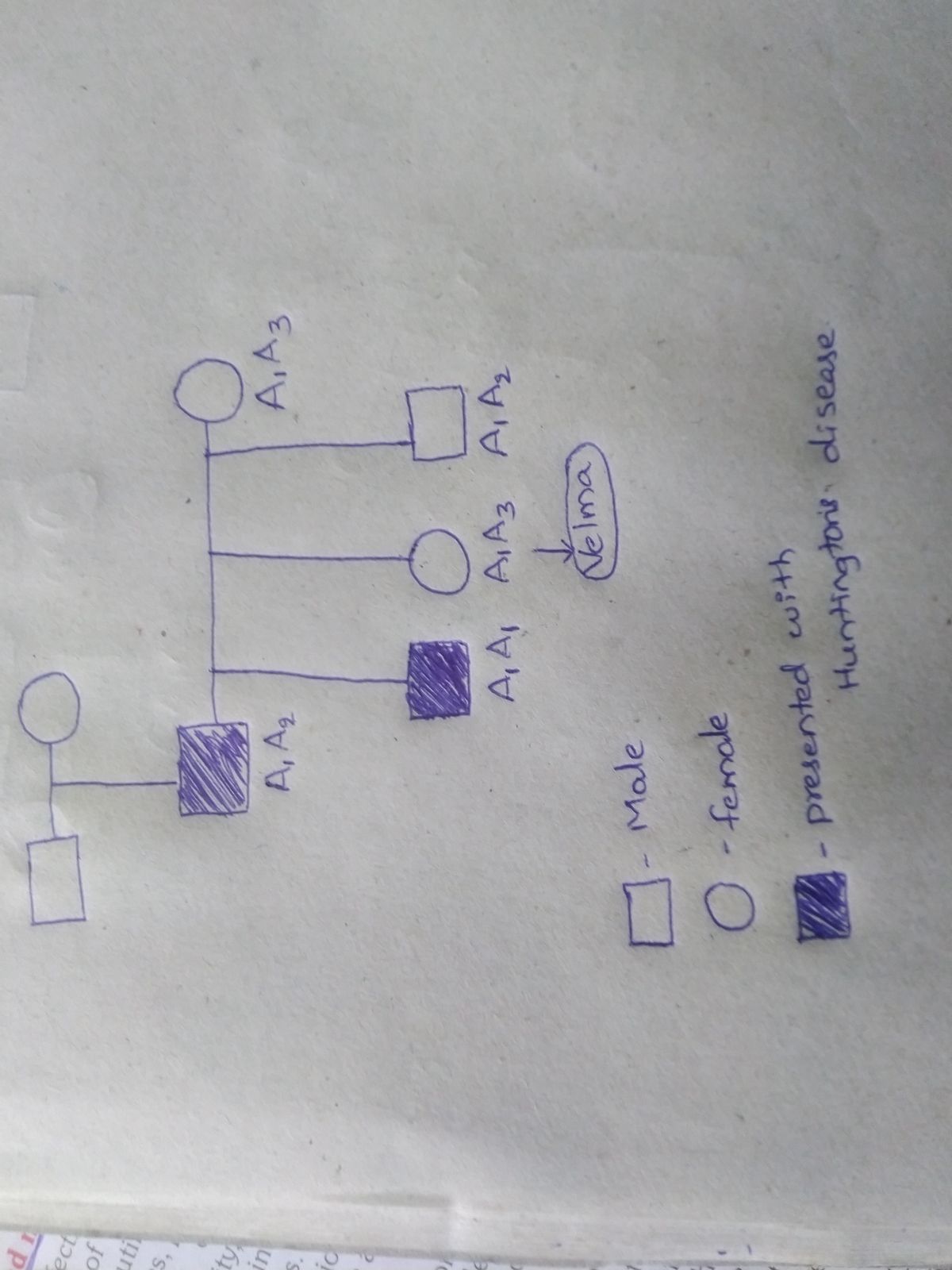6. Assuming no crossing over occurs between the Huntington gene and th develop Huntington Disease? Will her younger brother develop Huntin 7. Assuming no crossing over occurs between the Huntington gene and th the chance that Velma will pass the Huntington Disease gene to her pro not carry the disease gene?
6. Assuming no crossing over occurs between the Huntington gene and th develop Huntington Disease? Will her younger brother develop Huntin 7. Assuming no crossing over occurs between the Huntington gene and th the chance that Velma will pass the Huntington Disease gene to her pro not carry the disease gene?
Human Anatomy & Physiology (11th Edition)
11th Edition
ISBN:9780134580999
Author:Elaine N. Marieb, Katja N. Hoehn
Publisher:Elaine N. Marieb, Katja N. Hoehn
Chapter1: The Human Body: An Orientation
Section: Chapter Questions
Problem 1RQ: The correct sequence of levels forming the structural hierarchy is A. (a) organ, organ system,...
Related questions
Question

Transcribed Image Text:5.
Draw the pedigree you constructed on the whiteboard for Exercise III.
6. Assuming no crossing over occurs between the Huntington gene and the SNP marker, will Velma
develop Huntington Disease? Will her younger brother develop Huntington Disease?
7. Assuming no crossing over occurs between the Huntington gene and the SNP marker, what is
the chance that Velma will pass the Huntington Disease gene to her progeny if her husband does
not carry the disease gene?

Transcribed Image Text:Exercise Ill:
For this lab exercise, you will evaluate a human pedigree for a particular disease, Huntington disease.
Huntington disease is a progressive neurodegenerative disorder that is inherited in an autosomal
dominant pattern. The disease presents around the age of 40, although there are juvenile onset
forms of the disease. Suppose that there is a SNP closely linked to the Huntington gene, so close that
there is little crossing over between the SNP and the Huntington gene.
Consider the following family:
Velma's father, now deceased, had Huntington Disease, but neither of his parents had the disease;
therefore, it was a new mutation that caused his disease. Velma's mother does not have the disease.
Before his death, Velma's father was genotyped for the SNP marker that is linked to the Huntington
gene, and it was determined that he has alleles A1 and A2. Velma's mother was also genotyped and
has alleles A1 and A3. Velma has one brother (age 45) who has Huntington Disease, and genotyping
of this brother revealed he has two copies of the A1 SNP allele. Velma has another brother (age 35)
who currently does not have symptoms of the disease, and has SNP alleles A1 and A2. At the age
of 37, Velma does not currently have symptoms of the disease, and genotyping of her SNP marker
revealed that she has alleles A1 and A3.
1. Using your whiteboard, construct a pedigree for this family, using filled-in symbols to reflect
those with Huntington disease. Under each symbol, write the genotype of Velma, her parents,
and her brothers to reflect both the Huntington gene and the SNP marker. Assume that no
crossing over takes place between the gene and the marker. Transfer your pedigree and the
genotypes to #5 on the Data Sheet.
Hint: to write the genotypes, be sure to illustrate the linkage between the Huntington gene and
the SNP marker so that you can visualize what is on each chromosome. For example, an individual
without Huntington Disease with SNP alleles A2 and A3 would be written as:
h A2
h A3
2. Based on the pedigree you constructed, answer questions 6-8 on the Data Sheet.
Expert Solution
Step 1

Trending now
This is a popular solution!
Step by step
Solved in 3 steps with 1 images

Knowledge Booster
Learn more about
Need a deep-dive on the concept behind this application? Look no further. Learn more about this topic, biology and related others by exploring similar questions and additional content below.Recommended textbooks for you

Human Anatomy & Physiology (11th Edition)
Biology
ISBN:
9780134580999
Author:
Elaine N. Marieb, Katja N. Hoehn
Publisher:
PEARSON

Biology 2e
Biology
ISBN:
9781947172517
Author:
Matthew Douglas, Jung Choi, Mary Ann Clark
Publisher:
OpenStax

Anatomy & Physiology
Biology
ISBN:
9781259398629
Author:
McKinley, Michael P., O'loughlin, Valerie Dean, Bidle, Theresa Stouter
Publisher:
Mcgraw Hill Education,

Human Anatomy & Physiology (11th Edition)
Biology
ISBN:
9780134580999
Author:
Elaine N. Marieb, Katja N. Hoehn
Publisher:
PEARSON

Biology 2e
Biology
ISBN:
9781947172517
Author:
Matthew Douglas, Jung Choi, Mary Ann Clark
Publisher:
OpenStax

Anatomy & Physiology
Biology
ISBN:
9781259398629
Author:
McKinley, Michael P., O'loughlin, Valerie Dean, Bidle, Theresa Stouter
Publisher:
Mcgraw Hill Education,

Molecular Biology of the Cell (Sixth Edition)
Biology
ISBN:
9780815344322
Author:
Bruce Alberts, Alexander D. Johnson, Julian Lewis, David Morgan, Martin Raff, Keith Roberts, Peter Walter
Publisher:
W. W. Norton & Company

Laboratory Manual For Human Anatomy & Physiology
Biology
ISBN:
9781260159363
Author:
Martin, Terry R., Prentice-craver, Cynthia
Publisher:
McGraw-Hill Publishing Co.

Inquiry Into Life (16th Edition)
Biology
ISBN:
9781260231700
Author:
Sylvia S. Mader, Michael Windelspecht
Publisher:
McGraw Hill Education